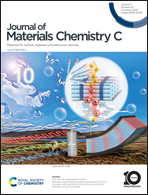Strain-engineering induced topological phase transitions and multiple valley states in Janus monolayer VCSiN4†
Abstract
It is crucial to manipulate the valley degree of freedom for the valleytronics and spintronics development, which offers fascinating opportunities in both practical applications and fundamental research. Here, based on the first-principles calculations and Monte Carlo (MC) simulations, for out-of-plane (OOP) magnetic anisotropy, when the biaxial strain (a/a0) varies between 1.04 and 1.043, we prove that the Quantum anomalous valley Hall effect (QAVHE) appears in a ferrovalley (FV) monolayer, the Janus monolayer VCSiN4, in which the edge state has a significant feature of chiral spin-valley locking. Moreover, VCSiN4 has half-valley-metal (HVM) states and the conduction electrons are 100% valley polarized under tensile strains of 1.04 and 1.043. By continuing to change the strain, the system will change into a FV semiconductor with the anomalous valley Hall effect (AVHE). The continuous band inversion of the V-d orbitals in the +K and −K valleys leads to topological phase transitions. Furthermore, we discover that the topological phase transitions cause a sign-reversible Berry curvature in different valleys. Nevertheless, for in-plane (IP) magnetic anisotropy, particular QAVHE states and spontaneous valley polarization are not observed within the investigated strain range. The magnetic anisotropy energy (MAE) of the Janus monolayer VCSiN4 indicates no HVM and QAVHE states. Fortunately, the easy magnetization axis direction can be easily converted into OOP utilizing an external magnetic field. For the experimental explorations and practical applications, our work provides an excellent material platform in spintronics, topology, and valleytronics.



 Please wait while we load your content...
Please wait while we load your content...